Forget everything you knew about inkjet printers. Finally, the technology has emerged that will forever put an end to the «childish problems» of inkjet printing such as low printing speed, noise and vibration, wet prints, drying printing head. Today we are talking about the birth of a new generation of printers – allowing to print with fantastic speed, excellent quality and several times cheaper in comparison with laser counterparts.
How did this become possible? The key point of the new technology is the use of a fixed printing head, which implements the FHC printing technology. Previously, in inkjet printers, the head bypassed the whole printable area for a number of passes. Now the head remains fixed and is capable of releasing up to a billion drops of dye per second. Therefore, we can manifold increase the speed of paper feeding and receive prints with saturated sharp colors in just one pass.
The temperature of the heating element in the head rises to 600 C in 2 millionths of a second (2 * 10-6 sec) by an energy flow of 1 billion watts per m2. Such a flow of energy is comparable with the energy flux on the surface of the Sun. Under the pressure of 125 atmospheres, the drop breaks out of the head nozzle and rushes into the thickness of a paper sheet. This process is repeated up to 12,000 times per second.
Traditional printers ALWAYS leave about 5 mm technical margins at each side that constitutes approximately 5% of the A4 sheet area. They clearly show that the document was printed in the office.
FHC printing uses the whole surface of the sheet leaving no margins. The document looks as if it was printed in a printing office.
The printing head covers the whole A4 sheet surface. It is firmly fixed on a frame and does not move along the sheet.
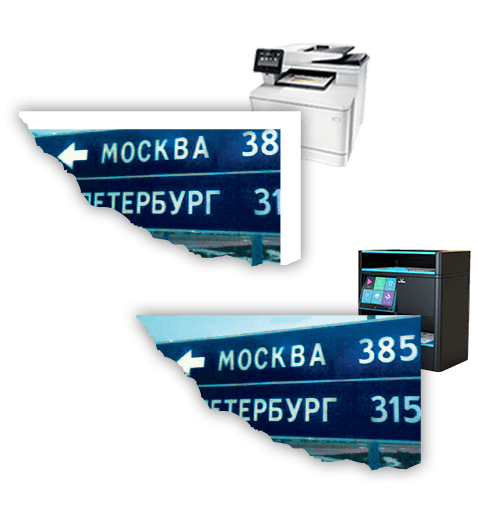
A fixed printing head is the most complex and multi-component printer unit. It is enough to say that the technology of its development has taken over 5 years of research. The printing head is a module on which thousands of nozzles that emit a dye are located. In order for the dye drops to fall into a defined location on a moving paper sheet, all components must be manufactured with a perfect accuracy. This is a real super task, considering that the chambers, nozzles, channels and resistors do not exceed the thickness of a human hair. For this reason, all details of the head are made in laboratory by the photolithography method ‒ a process that allows the creation of microscopic structures. Monolithic at first glance, the module is assembled from a dozen separate sections with a width of 20 mm, docked together. There are a thousand nozzles in the section, and in total, up to 70,000 nozzles can be placed on the printing head module, which is 17 times more than on the printing heads of the old generation! Each section has a fast microchip that controls its operation and an individual channel for supplying the dye.
To ensure that the nozzles in the printing head are not clogged, 3 cleaning systems have been created, eliminating the possibility of drying the dye inside the head and preventing jamming of the nozzles. The printing head belongs to jet thermal devices: the ejection of dye droplets occurs with the help of miniature heating elements (thermo-resistors) located under each nozzle. The voltage is applied to the thermo-resistor, and it instantly heats the drop of the dye. In our case, the dye is a mixture of a solid particle and water. When heated, the water evaporates, and the resulting gas pushes the drop out of the nozzle. Flying just a millimeter to the paper, the pigment particle can develop a speed of up to 1270 cm per second. Having reached the paper, it puts the point exactly in the place where it is required. This operation is repeated at the head tens of thousands of times per second, and over this time more than 700,000,000 drops can be discharged onto the paper. That’s why katusha is able to print the page in less than a second.
Device scalability is one of the advantages of our technology. A multitude of minisections constitutes the head. By changing their number, we can produce equipment of almost any size ‒ from a matchbox-sized printer to a widescreen plotter.
The process of dye heating and evaporation is accompanied by a thermal energy flow, whose density is comparable to the one on the sun surface.


The process of dye heating and evaporation is accompanied by a thermal energy flow, whose density is comparable to the one on the sun surface.
Pigment dyes are used in katusha printer, and there are several reasons for this.
Permanence. Pigment dyes are an emulsion with insoluble pigment microparticles. Solid particles of pigment fall into the thickness of the sheet, and are not absorbed as water-soluble ink. Due to this, the printed documents have a higher degree of light and water resistance and are capable of preserving the color rendition for several months under intensive illumination. In archives, these prints can be stored for 100 years or more without quality loss. Not to mention the fact that an accidental rain will not affect the report. For the same reason, pigment dyes are excellent for two-sided printing: a sheet with an applied pigment is not as intensively visible as a page printed with water-soluble inks.
High printing quality. Only pigments can provide the most saturated colors and clarity of lines. When applied to paper ink with paint spreads or unequally penetrates into the material. For this reason, for example, black color loses depth when printed and looks faded. Pigments are quickly fixed in the near-surface layer of paper and provide a bright, clear and saturated image.
Quick drying of pages. With pigment dyes, you do not need to hold the sheet by the edges carefully, waiting until the paint dries. You also do not need to carry a hot stack of the report printed on a laser printer. The application technology and the type of dyes used guarantee an irreproachable result right at the output: a qualitatively printed page that you can immediately take to the meeting.
Flexibility of the formula. Since the pigments do not dissolve in water, we have the opportunity to change the recipe without compromising the final image when composing the formula of dyes. Thus, for example, non-freezing, self-destructing dyes, or dyes with radio tags can be developed, which may be relevant for use in such fields as logistics, security and others.
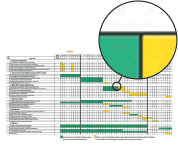
Water-soluble inks: the sheet gets wet; the image smears out and fades.
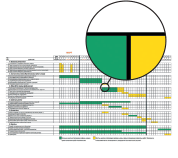
Pigment dye: the sheet DOES NOT get wet, the image remains distinct.
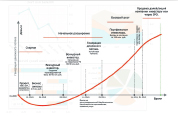
Water-soluble inks: the image on the reverse side is visible.
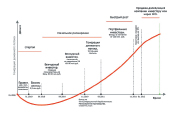
Pigment dye: the reverse image is NOT visible.
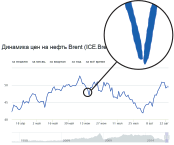
Laser printer: the lines are distorted, the lines are dashed and of different thickness.
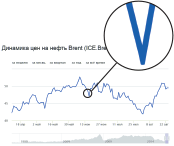
Pigment dye: an ideal not distorted image.